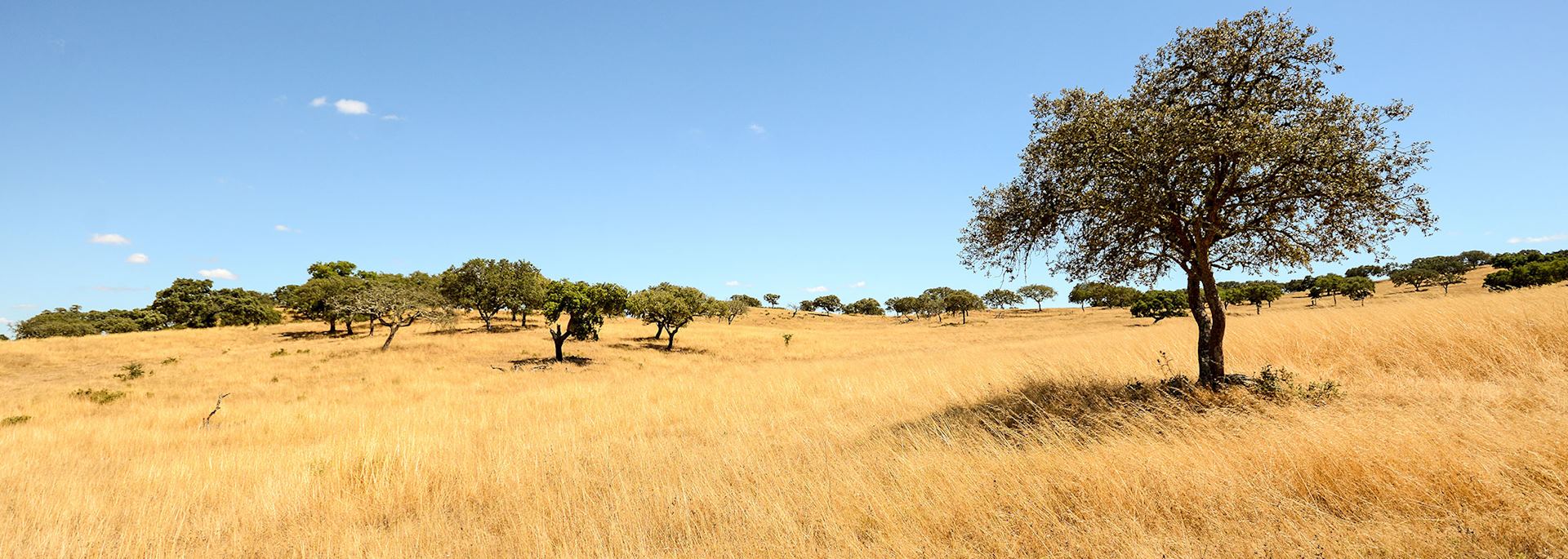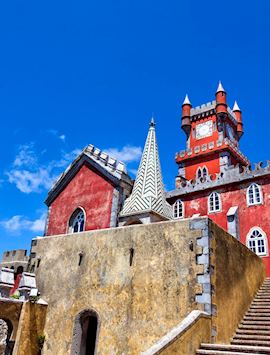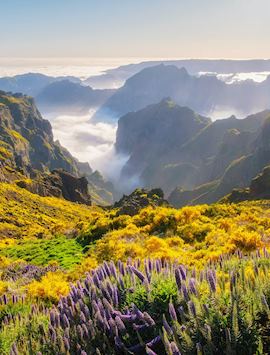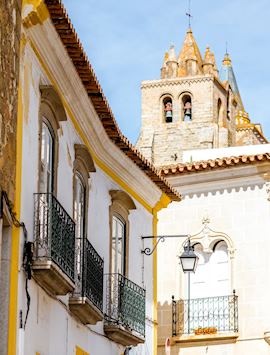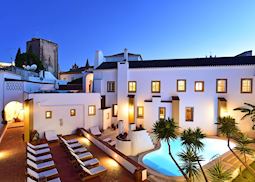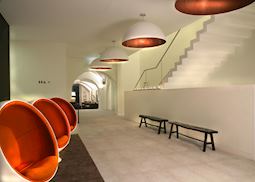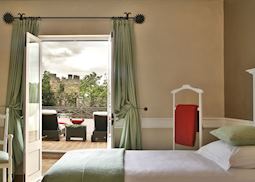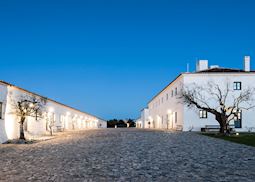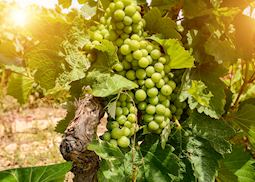Jump to:
‘The land beyond the Tagus’, the Alentejo is the countryside of central Portugal. It’s a dry, dusty, land filled with sun-baked vineyards, sparse cork oak forests and vast wheat fields, occasionally punctuated by a small village of whitewashed houses or a walled medieval town.
Évora, the walled provincial capital, is a good base for exploring the region as well as a destination in its own right. The well-preserved city is a UNESCO World Heritage Site thanks to its Moorish alleyways, intact medieval walls, Roman ruins and Gothic cathedral. The city is also a cultural hub, with a lively student population and exceptional restaurants focused around the local cuisine.
Spain & Portugal specialist KevinIf you want a glimpse of authentic Portuguese life, Évora is great for its sleepy, small-town feel. Compact and easy to navigate, its narrow streets and white buildings give it the feel of a campus.
Things to see and do in Évora and the Alentejo
Alentejo gastronomy
An agricultural breadbasket since Roman times and home of almost half of Portugal’s wines, the Alentejo is considered the heart of the country’s gastronomy. The culinary culture here is as rich and subtle as you’d find in Italy or France, with a focus on meat and seasonal local ingredients. Dishes contain fresh game, Iberian black pork, peppery olive oils, wild mushrooms and a wealth of sheep-milk cheeses.
The gentle hills of the region support vast fields of wheat, and bread is central to many dishes — almost all soups are served with a slice at the bottom of the bowl. The vineyards produce rich, balanced vintages, often using native grapes that are unknown elsewhere. Some Alentejo wines are still produced using techniques that hark back to the Roman era, in towering terracotta amphorae called talhas.
Despite its small size, Évora is blessed with an abundance of exceptional restaurants.
Templo Romano and Termas Romanas
A colonnade of 14 granite Corinthian columns, the Templo Romano stands right in the middle of Évora. Once a section of the Roman forum, in medieval times it was built into a fort, which might have helped it withstand the Great Earthquake of 1755. It was only uncovered in the 19th century and remains an airy and graceful structure, almost 2,000 years after it was built.
Historians debate the original purpose of the temple — it’s often called the Temple of Diana, but there’s no proof that it was dedicated to the goddess in question.
A five-minute walk away, you can find another well-preserved Roman ruin. A public bathhouse was uncovered during renovations of the city hall in 1989, including a laconicum (steam bath) with a huge circular pool. An open-air swimming pool was discovered in 1994. The ruins are on display, for free, inside the town hall.
Aqueduto da Água de Prata
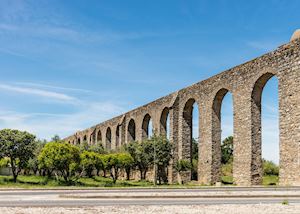 Évora’s original Roman aqueduct was rebuilt in 1537 in a massive municipal project headed by Francisco de Arruda, the architect best known for the Torre de Belém.
Évora’s original Roman aqueduct was rebuilt in 1537 in a massive municipal project headed by Francisco de Arruda, the architect best known for the Torre de Belém.
Widely considered one of the greatest engineering feats of the 16th century, it brought clean water to the city until 1979. The slyly evocative name translates to ‘The Silver Water Aqueduct’ and may refer to the silvery waters or to the extraordinary cost of construction, which nearly bankrupted the city government.
The stone structure begins in the heart of the city and extends out to the northwest, with many shops and houses built directly into the high arches.
Évora Cathedral
Built in the late 12th century, shortly after the Moors were ejected from the city, the Évora Cathedral, or the Sé, has a rather fortress-like exterior, with two mighty rose-granite towers and substantial battlements. The interior is a soaring, solemn Gothic affair, lit by two rose windows.
The museum has, among other treasures, a jewel-studded reliquary, said to contain a fragment of the cross. It rests on golden cherubs and is flanked by two Ming vases.
The cloisters are a latter-day addition and overlook a garden. In each corner of the cloisters, you’ll find a narrow, dark spiral stair that reaches the tops of the walls, offering a panoramic view of the city’s ocher-tiled roofs and the countryside beyond.
Church of Saint Francis and the Chapel of Bones
The fairly uninspired Church of Saint Francis, built in the 15th century, is one of the city’s most popular sights thanks to a strange addition that was built a century later — a chapel made of bones. One of two in Portugal (the other is in Faro), the oratory is lined entirely with skulls and bones, arranged with a ghoulish sense of whimsy.
The material for the morbid decor comes from monks buried in the area during the 15th and 16th centuries. The graveyards took up too much valuable land and the Franciscan order’s grimly practical solution was to condense the remnants of their mortal remains into one location.
The intention was to highlight the brevity of life, a sentiment underscored by the pointed inscription over the entrance. It translates, loosely, as ‘We bones, which are here, await yours.’
Cromeleque dos Almendres
Located on a hillside about 30 minutes to the west of Évora, Cromeleque dos Almendres is a vast field dotted with nearly 100 granite megaliths. The rounded boulders stand arrayed in a loose oval that stretches about 70 m (230 ft) down a south-facing slope.
The hulking stones, some taller than a basketball player, were erected during different periods — the earliest dates to the dawn of the Neolithic period, approximately 7,000 years ago. They’re astronomically aligned, and, on the spring and autumn equinoxes, the sun rises along the axis of the oval, leading experts to speculate that it was used for rituals.
The site was uncovered in 1966 and doesn’t offer much in the way of facilities. Arriving along the dirt road you can easily wander into the open, dusty field where the stones stand, grouped together like a very quiet cocktail party.
Best time to visit Évora and the Alentejo
Summers in the Alentejo are often very hot, so we suggest visiting in the spring months of March to May, or in September and October. Winter travel is also an option — the weather is somewhat unpredictable, but the rains are much lighter than elsewhere in Portugal and the temperatures are usually mild.
who's been there

Start planning your tailor-made trip to Évora & the Alentejo by contacting one of our Portugal specialists
- 617-223-4772
- Make an inquiry
Suggested itineraries featuring Évora & the Alentejo
Our itineraries will give you suggestions for what is possible when you travel in Évora & the Alentejo, and they showcase routes we know work particularly well. Treat them as inspiration, because your trip will be created uniquely by one of our specialists.
Places near Évora & the Alentejo
- Lisbon 108 kilometers away
- Estremadura 109 kilometers away
- µ₫±đ±ôĂ©³¾ 115 kilometers away
- Sintra 132 kilometers away
- Algarve 173 kilometers away
- Coimbra 187 kilometers away
- Douro Valley 290 kilometers away
- Porto 294 kilometers away
- Braga and GuimarĂ£es 334 kilometers away
Photos of Évora & the Alentejo
Accommodation choices for Évora & the Alentejo
We've selected a range of accommodation options for when you visit Évora & the Alentejo. Our choices usually come recommended for their character, facilities and service or location. Our specialists always aim to suggest properties that match your preferences.
-
![Pousada Convento de Évora, Évora]()
Pousada Convento de Évora
Évora & the Alentejo -
![Hotel M'AR De AR Aqueduto, Évora]()
M’AR de AR Aqueduto
Évora & the Alentejo -
![Hotel M'AR De AR Muralhas, Évora]()
Hotel M'AR de AR Muralhas
Évora & the Alentejo -
![SĂ£o Lourenço do Barrocal, Monsaraz]()
SĂ£o Lourenço do Barrocal
Évora & the Alentejo
Ideas for experiencing Évora & the Alentejo
Our specialists seek out authentic ways to get to know the places that could feature in your trip. These activities reflect some of the experiences they've most enjoyed while visiting Évora & the Alentejo, and which use the best local guides.
-
Alentejo wine tour with wine pairing lunch ![Grape vine, Alentejo]()
Alentejo wine tour with wine pairing lunch
Alentejo wine tour with wine pairing lunch
Explore the wineries of the Alentejo region on a full-day tour that includes a wine-pairing lunch and visits to two wineries. Along the way, you’ll learn about the history and traditions of one of Portugal’s premier wine-producing regions.
View details
